外研版(2019)高中英语必修3课件:Unit 1 Knowing me, knowing you Using language(28张ppt)
文档属性
| 名称 | 外研版(2019)高中英语必修3课件:Unit 1 Knowing me, knowing you Using language(28张ppt) |  | |
| 格式 | ppt | ||
| 文件大小 | 5.9MB | ||
| 资源类型 | 教案 | ||
| 版本资源 | 外研版(2019) | ||
| 科目 | 英语 | ||
| 更新时间 | 2021-03-28 16:38:33 | ||
图片预览

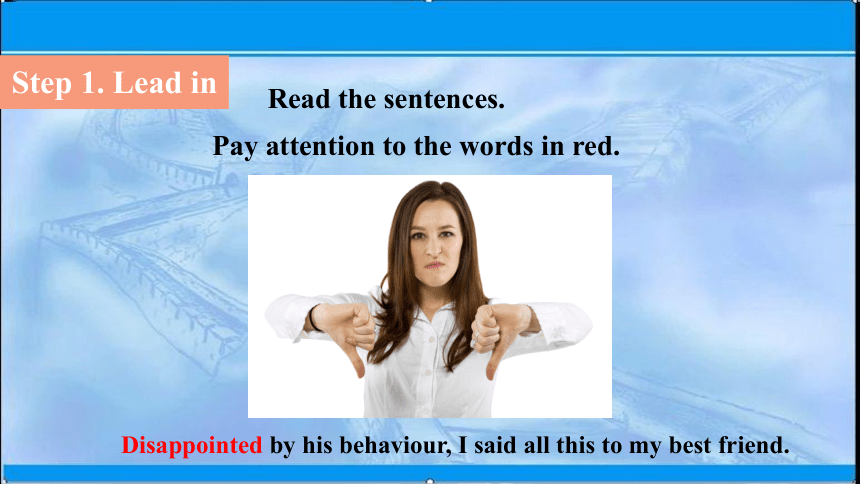
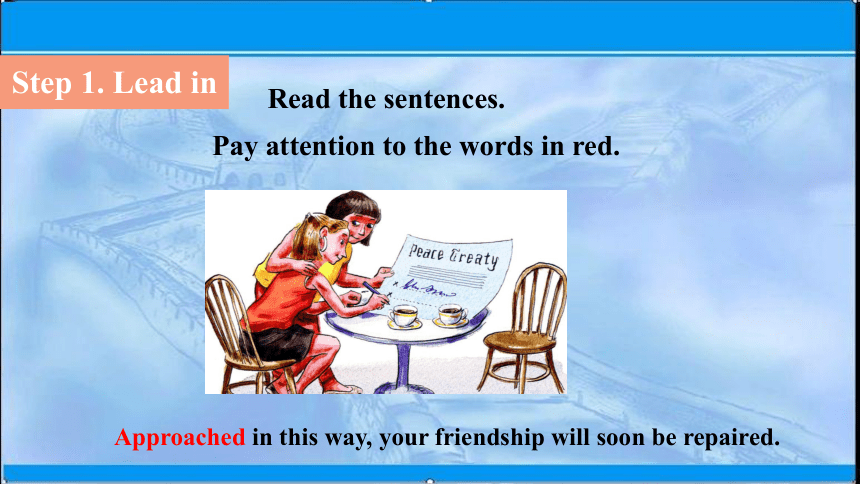


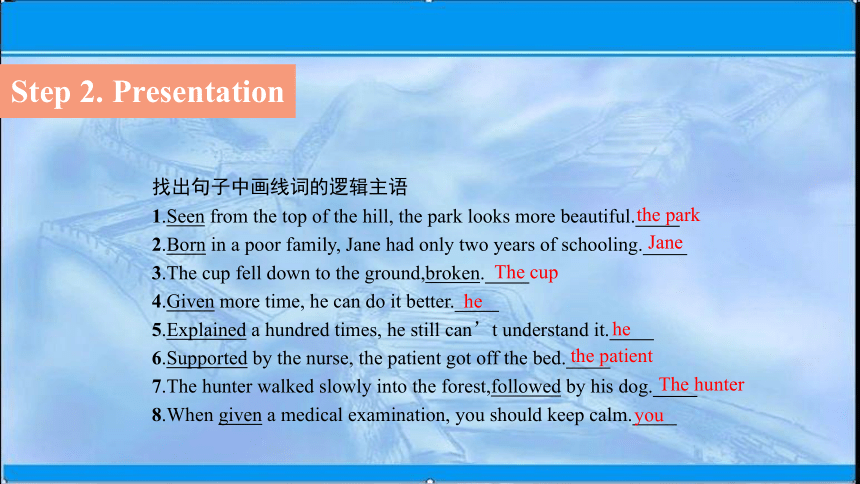
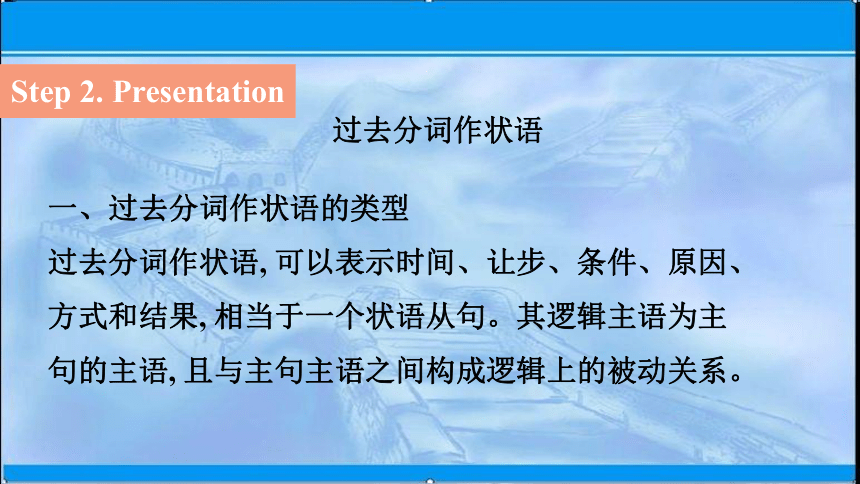
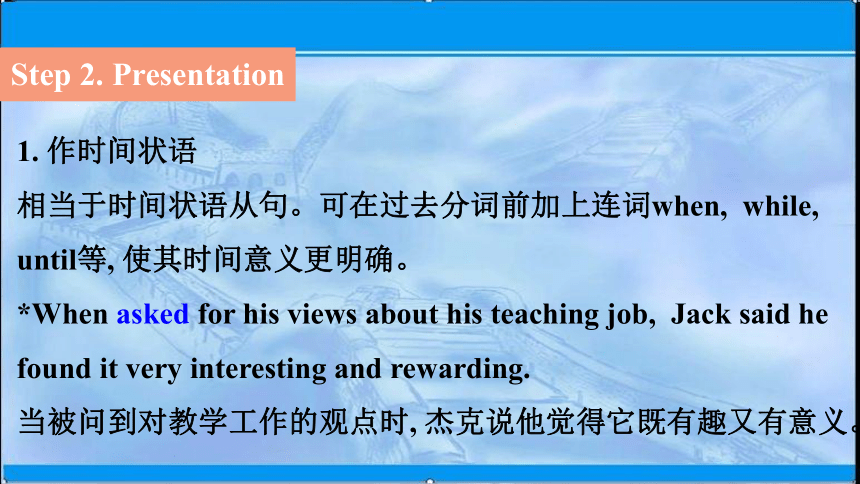
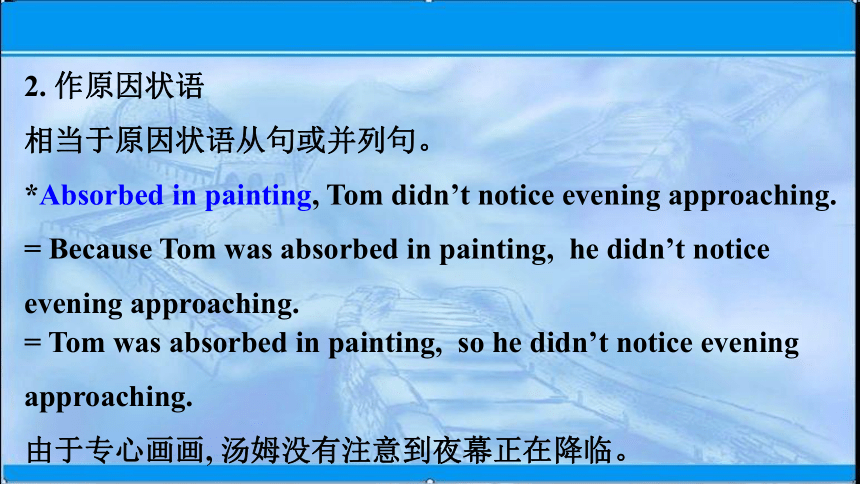
文档简介
Unit 1 Knowing me, knowing you
Using language
Read the sentences.
Step 1. Lead in
Pay attention to the words in red.
Disappointed by his behaviour, I said all this to my best friend.
Read the sentences.
Step 1. Lead in
Pay attention to the words in red.
Approached in this way, your friendship will soon be repaired.
过去分词作状语
过去分词起副词的作用, 在句中作状语, 它的正确运用能使句子更好地表情达意。
Step 1. Lead in
观察探究:
(1)作状语用的过去分词(短语)和句子的主语之间有逻辑上的动宾关系, 或称为_____关系。
(2)
被动
Because I was disappointed by his behaviour, I said all this to my best friend.
Disappointed by his behaviour, I said all this to my best friend.
Approached in this way, your friendship will soon be repaired.
If your friendship is approached in this way, it will soon be repaired.
过去分词作状语可以表示时间、原因、条件、让步、方式或伴随情况等,可以转化成相应的状语从句。例如:
找出句子中画线词的逻辑主语
1.Seen from the top of the hill, the park looks more beautiful. ?
2.Born in a poor family, Jane had only two years of schooling. ?
3.The cup fell down to the ground,broken. ?
4.Given more time, he can do it better. ?
5.Explained a hundred times, he still can’t understand it. ?
6.Supported by the nurse, the patient got off the bed. ?
7.The hunter walked slowly into the forest,followed by his dog. ?
8.When given a medical examination, you should keep calm. ?
the park
Jane
The cup
he
he
the patient
The hunter
you
Step 2. Presentation
一、过去分词作状语的类型
过去分词作状语, 可以表示时间、让步、条件、原因、方式和结果, 相当于一个状语从句。其逻辑主语为主句的主语, 且与主句主语之间构成逻辑上的被动关系。
过去分词作状语
Step 2. Presentation
1. 作时间状语
相当于时间状语从句。可在过去分词前加上连词when, while, until等, 使其时间意义更明确。
*When asked for his views about his teaching job, Jack said he found it very interesting and rewarding.
当被问到对教学工作的观点时, 杰克说他觉得它既有趣又有意义。
Step 2. Presentation
2. 作原因状语
相当于原因状语从句或并列句。
*Absorbed in painting, Tom didn’t notice evening approaching.
= Because Tom was absorbed in painting, he didn’t notice evening approaching.
= Tom was absorbed in painting, so he didn’t notice evening approaching.
由于专心画画, 汤姆没有注意到夜幕正在降临。
3. 作条件状语
相当于条件状语从句。可加连词if, unless等转换成条件状语从句。
*Used with care, one tin will last for six weeks.
=If it is used with care, one tin will last for six weeks.
如果用得仔细的话, 一罐可以够用六周。
4. 作让步状语
相当于让步状语从句。有时可加although, though, even if, even though, whether . . . or. . . 等连词转换成让步状语从句。
*Defeated by his opponent, he never gave up any hope.
= Although he was defeated by his opponent, he never gave up any hope.
尽管被对手击败, 但是他从没放弃希望。
5. 作方式、伴随状语
相当于and连接的并列句。
*She accepted the gift, deeply moved.
=She accepted the gift, and she was deeply moved.
她接受了礼物, 深深地被感动了。
有些过去分词(短语)因来源于系表结构, 作状语时不强调被动而重在描述主语的状态。这样的过去分词(短语)常见的有: lost (迷路); seated (坐); hidden (躲); lost/absorbed in (沉溺于); dressed in (穿着); tired of (厌烦)。
*Lost in thought, he didn’t hear the doorbell.
由于陷入沉思之中, 他没有听到铃声。
(3)Children, when ____________ (accompany) by their parents, are allowed to enter the stadium.
(4)________ (found) in the early 20th century, the school keeps on inspiring children’s love of art.
(5)__________ (translate) into English, the sentence was found to have an entirely different word order.
accompanied
Founded
Translated
【即学即练】
用所给词的适当形式填空
(1)_________ (develop) by two doctors in the U. S. Department of Agriculture, it’s an excellent water collector.
(2)______ (raise) in the poorest area of Glasgow, he had a long, hard road to becoming a football star.
Developed
Raised
二、过去分词作状语时的位置
过去分词作条件、原因及时间状语时, 通常放在句首; 作伴随、结果状语时, 通常放在句末; 作方式状语时, 一般放在句末, 有时也放在句首; 作让步状语时, 一般放在句首, 有时也放在句末。
*Told that his mother was ill, the boss hurried home quickly.
(原因状语)
得知母亲生病了, 老板迅速赶回了家。
*The old man walked into the room, supported by his son.
(方式状语)
老人在儿子的搀扶下走进了房间。
三、过去分词的独立结构作状语
过去分词作状语时, 有时在分词前加上自己的主语, 这种带有自身主语的过去分词被称为过去分词的独立结构。过去分词的独立结构在句中作状语时, 通常可表示时间、原因、条件等。
*Much time spent sitting at a desk, office workers are generally troubled by health problems.
很多时间都坐在办公桌旁, 办公室职员一般都受到健康问题的困扰。
【即学即练】
用独立主格结构作状语改写句子
(1)After the lecture was given, a lively question-and-answer session followed.
→____ ______ _____, a lively question-and-answer session followed.
The
lecture
given
(2)The factory produced many famous cars, none of which were shipped to foreign countries.
→The factory produced many famous cars, _____ __ _____ _______ to foreign countries.
(3)Because extra money was given to the poor, he felt very happy.
→_____ ______ _____ to the poor, he felt very happy.
none
of
them
shipped
Extra
money
given
四、过去分词与现在分词作状语的区别
过去分词与句子的主语之间存在逻辑上的动宾关系, 即表示被动; 现在分词与句子的主语之间存在逻辑上的主谓关系, 即表示主动。
*Used for a long time, the book looks old. (动宾关系)
由于用了很长时间, 这本书看上去很旧。
*Using the book, I find it very useful. (主谓关系)
在使用这本书时, 我发现它很有用。
【巧学助记】分词作状语记忆口诀
分词作状语, 主语是问题。
前后两动作, 共用一主语。
主语找出后, 再来判关系。
主动用-ing, 被动用-ed。
无论是现在分词还是过去分词, 其逻辑主
语必须和句子的主语一致。如果不一致, 则必须用状语
从句或独立主格结构等其他表达形式。
Giving more time, we can finish the work. ( )
Given more time, we can finish the work. ( )
If we are given more time, we can finish the work. ( )
More time given, we can finish the work. ( )
×
√
√
√
【即学即练】用所给词的适当形式填空
(1)When I was little, my mother used to sit by my bed,
______ (tell) me stories till I fell asleep.
(2)—Where is Jimmy?
—Just now I saw him sitting under the tree, ________
(absorb) in his video games.
telling
absorbed
watered
Seeing
solved
Step 3. Practice
separated
Attracted
preparing
Surprised
moved
exhausted
Looking
II.翻译句子
1.水加热后会变成蒸汽。
2.当有人问他怎么闯进屋里来时,他一声不吭。
3.由于被电影深深打动,我们都哭了。
4.出生于贫苦家庭,他只上了两年学。
5.如果给我们的帮助多一些,我们本来能把这项工作做得更好。
Step 3. Practice
1.When heated,water will be turned into steam.
2.Asked how he broke into the room, he made no answer.
3.Deeply moved by the film, we all cried.
4.Born into a poor family, he had no more than two years of schooling.
5.Given more help, we could have done the work better.
Work in pairs.
Talk about the problems you met or your feelings.
E.g.
Confused by the problem, I asked my teacher for help.
Attracted by the Great Wall, I decided to visit it someday.
Praised by the strangers, I felt very happy.
Step 4. Production
Thank You
Unit 1 Knowing me, knowing you
Using language
Read the sentences.
Step 1. Lead in
Pay attention to the words in red.
Disappointed by his behaviour, I said all this to my best friend.
Read the sentences.
Step 1. Lead in
Pay attention to the words in red.
Approached in this way, your friendship will soon be repaired.
过去分词作状语
过去分词起副词的作用, 在句中作状语, 它的正确运用能使句子更好地表情达意。
Step 1. Lead in
观察探究:
(1)作状语用的过去分词(短语)和句子的主语之间有逻辑上的动宾关系, 或称为_____关系。
(2)
被动
Because I was disappointed by his behaviour, I said all this to my best friend.
Disappointed by his behaviour, I said all this to my best friend.
Approached in this way, your friendship will soon be repaired.
If your friendship is approached in this way, it will soon be repaired.
过去分词作状语可以表示时间、原因、条件、让步、方式或伴随情况等,可以转化成相应的状语从句。例如:
找出句子中画线词的逻辑主语
1.Seen from the top of the hill, the park looks more beautiful. ?
2.Born in a poor family, Jane had only two years of schooling. ?
3.The cup fell down to the ground,broken. ?
4.Given more time, he can do it better. ?
5.Explained a hundred times, he still can’t understand it. ?
6.Supported by the nurse, the patient got off the bed. ?
7.The hunter walked slowly into the forest,followed by his dog. ?
8.When given a medical examination, you should keep calm. ?
the park
Jane
The cup
he
he
the patient
The hunter
you
Step 2. Presentation
一、过去分词作状语的类型
过去分词作状语, 可以表示时间、让步、条件、原因、方式和结果, 相当于一个状语从句。其逻辑主语为主句的主语, 且与主句主语之间构成逻辑上的被动关系。
过去分词作状语
Step 2. Presentation
1. 作时间状语
相当于时间状语从句。可在过去分词前加上连词when, while, until等, 使其时间意义更明确。
*When asked for his views about his teaching job, Jack said he found it very interesting and rewarding.
当被问到对教学工作的观点时, 杰克说他觉得它既有趣又有意义。
Step 2. Presentation
2. 作原因状语
相当于原因状语从句或并列句。
*Absorbed in painting, Tom didn’t notice evening approaching.
= Because Tom was absorbed in painting, he didn’t notice evening approaching.
= Tom was absorbed in painting, so he didn’t notice evening approaching.
由于专心画画, 汤姆没有注意到夜幕正在降临。
3. 作条件状语
相当于条件状语从句。可加连词if, unless等转换成条件状语从句。
*Used with care, one tin will last for six weeks.
=If it is used with care, one tin will last for six weeks.
如果用得仔细的话, 一罐可以够用六周。
4. 作让步状语
相当于让步状语从句。有时可加although, though, even if, even though, whether . . . or. . . 等连词转换成让步状语从句。
*Defeated by his opponent, he never gave up any hope.
= Although he was defeated by his opponent, he never gave up any hope.
尽管被对手击败, 但是他从没放弃希望。
5. 作方式、伴随状语
相当于and连接的并列句。
*She accepted the gift, deeply moved.
=She accepted the gift, and she was deeply moved.
她接受了礼物, 深深地被感动了。
有些过去分词(短语)因来源于系表结构, 作状语时不强调被动而重在描述主语的状态。这样的过去分词(短语)常见的有: lost (迷路); seated (坐); hidden (躲); lost/absorbed in (沉溺于); dressed in (穿着); tired of (厌烦)。
*Lost in thought, he didn’t hear the doorbell.
由于陷入沉思之中, 他没有听到铃声。
(3)Children, when ____________ (accompany) by their parents, are allowed to enter the stadium.
(4)________ (found) in the early 20th century, the school keeps on inspiring children’s love of art.
(5)__________ (translate) into English, the sentence was found to have an entirely different word order.
accompanied
Founded
Translated
【即学即练】
用所给词的适当形式填空
(1)_________ (develop) by two doctors in the U. S. Department of Agriculture, it’s an excellent water collector.
(2)______ (raise) in the poorest area of Glasgow, he had a long, hard road to becoming a football star.
Developed
Raised
二、过去分词作状语时的位置
过去分词作条件、原因及时间状语时, 通常放在句首; 作伴随、结果状语时, 通常放在句末; 作方式状语时, 一般放在句末, 有时也放在句首; 作让步状语时, 一般放在句首, 有时也放在句末。
*Told that his mother was ill, the boss hurried home quickly.
(原因状语)
得知母亲生病了, 老板迅速赶回了家。
*The old man walked into the room, supported by his son.
(方式状语)
老人在儿子的搀扶下走进了房间。
三、过去分词的独立结构作状语
过去分词作状语时, 有时在分词前加上自己的主语, 这种带有自身主语的过去分词被称为过去分词的独立结构。过去分词的独立结构在句中作状语时, 通常可表示时间、原因、条件等。
*Much time spent sitting at a desk, office workers are generally troubled by health problems.
很多时间都坐在办公桌旁, 办公室职员一般都受到健康问题的困扰。
【即学即练】
用独立主格结构作状语改写句子
(1)After the lecture was given, a lively question-and-answer session followed.
→____ ______ _____, a lively question-and-answer session followed.
The
lecture
given
(2)The factory produced many famous cars, none of which were shipped to foreign countries.
→The factory produced many famous cars, _____ __ _____ _______ to foreign countries.
(3)Because extra money was given to the poor, he felt very happy.
→_____ ______ _____ to the poor, he felt very happy.
none
of
them
shipped
Extra
money
given
四、过去分词与现在分词作状语的区别
过去分词与句子的主语之间存在逻辑上的动宾关系, 即表示被动; 现在分词与句子的主语之间存在逻辑上的主谓关系, 即表示主动。
*Used for a long time, the book looks old. (动宾关系)
由于用了很长时间, 这本书看上去很旧。
*Using the book, I find it very useful. (主谓关系)
在使用这本书时, 我发现它很有用。
【巧学助记】分词作状语记忆口诀
分词作状语, 主语是问题。
前后两动作, 共用一主语。
主语找出后, 再来判关系。
主动用-ing, 被动用-ed。
无论是现在分词还是过去分词, 其逻辑主
语必须和句子的主语一致。如果不一致, 则必须用状语
从句或独立主格结构等其他表达形式。
Giving more time, we can finish the work. ( )
Given more time, we can finish the work. ( )
If we are given more time, we can finish the work. ( )
More time given, we can finish the work. ( )
×
√
√
√
【即学即练】用所给词的适当形式填空
(1)When I was little, my mother used to sit by my bed,
______ (tell) me stories till I fell asleep.
(2)—Where is Jimmy?
—Just now I saw him sitting under the tree, ________
(absorb) in his video games.
telling
absorbed
watered
Seeing
solved
Step 3. Practice
separated
Attracted
preparing
Surprised
moved
exhausted
Looking
II.翻译句子
1.水加热后会变成蒸汽。
2.当有人问他怎么闯进屋里来时,他一声不吭。
3.由于被电影深深打动,我们都哭了。
4.出生于贫苦家庭,他只上了两年学。
5.如果给我们的帮助多一些,我们本来能把这项工作做得更好。
Step 3. Practice
1.When heated,water will be turned into steam.
2.Asked how he broke into the room, he made no answer.
3.Deeply moved by the film, we all cried.
4.Born into a poor family, he had no more than two years of schooling.
5.Given more help, we could have done the work better.
Work in pairs.
Talk about the problems you met or your feelings.
E.g.
Confused by the problem, I asked my teacher for help.
Attracted by the Great Wall, I decided to visit it someday.
Praised by the strangers, I felt very happy.
Step 4. Production
Thank You
Using language
Read the sentences.
Step 1. Lead in
Pay attention to the words in red.
Disappointed by his behaviour, I said all this to my best friend.
Read the sentences.
Step 1. Lead in
Pay attention to the words in red.
Approached in this way, your friendship will soon be repaired.
过去分词作状语
过去分词起副词的作用, 在句中作状语, 它的正确运用能使句子更好地表情达意。
Step 1. Lead in
观察探究:
(1)作状语用的过去分词(短语)和句子的主语之间有逻辑上的动宾关系, 或称为_____关系。
(2)
被动
Because I was disappointed by his behaviour, I said all this to my best friend.
Disappointed by his behaviour, I said all this to my best friend.
Approached in this way, your friendship will soon be repaired.
If your friendship is approached in this way, it will soon be repaired.
过去分词作状语可以表示时间、原因、条件、让步、方式或伴随情况等,可以转化成相应的状语从句。例如:
找出句子中画线词的逻辑主语
1.Seen from the top of the hill, the park looks more beautiful. ?
2.Born in a poor family, Jane had only two years of schooling. ?
3.The cup fell down to the ground,broken. ?
4.Given more time, he can do it better. ?
5.Explained a hundred times, he still can’t understand it. ?
6.Supported by the nurse, the patient got off the bed. ?
7.The hunter walked slowly into the forest,followed by his dog. ?
8.When given a medical examination, you should keep calm. ?
the park
Jane
The cup
he
he
the patient
The hunter
you
Step 2. Presentation
一、过去分词作状语的类型
过去分词作状语, 可以表示时间、让步、条件、原因、方式和结果, 相当于一个状语从句。其逻辑主语为主句的主语, 且与主句主语之间构成逻辑上的被动关系。
过去分词作状语
Step 2. Presentation
1. 作时间状语
相当于时间状语从句。可在过去分词前加上连词when, while, until等, 使其时间意义更明确。
*When asked for his views about his teaching job, Jack said he found it very interesting and rewarding.
当被问到对教学工作的观点时, 杰克说他觉得它既有趣又有意义。
Step 2. Presentation
2. 作原因状语
相当于原因状语从句或并列句。
*Absorbed in painting, Tom didn’t notice evening approaching.
= Because Tom was absorbed in painting, he didn’t notice evening approaching.
= Tom was absorbed in painting, so he didn’t notice evening approaching.
由于专心画画, 汤姆没有注意到夜幕正在降临。
3. 作条件状语
相当于条件状语从句。可加连词if, unless等转换成条件状语从句。
*Used with care, one tin will last for six weeks.
=If it is used with care, one tin will last for six weeks.
如果用得仔细的话, 一罐可以够用六周。
4. 作让步状语
相当于让步状语从句。有时可加although, though, even if, even though, whether . . . or. . . 等连词转换成让步状语从句。
*Defeated by his opponent, he never gave up any hope.
= Although he was defeated by his opponent, he never gave up any hope.
尽管被对手击败, 但是他从没放弃希望。
5. 作方式、伴随状语
相当于and连接的并列句。
*She accepted the gift, deeply moved.
=She accepted the gift, and she was deeply moved.
她接受了礼物, 深深地被感动了。
有些过去分词(短语)因来源于系表结构, 作状语时不强调被动而重在描述主语的状态。这样的过去分词(短语)常见的有: lost (迷路); seated (坐); hidden (躲); lost/absorbed in (沉溺于); dressed in (穿着); tired of (厌烦)。
*Lost in thought, he didn’t hear the doorbell.
由于陷入沉思之中, 他没有听到铃声。
(3)Children, when ____________ (accompany) by their parents, are allowed to enter the stadium.
(4)________ (found) in the early 20th century, the school keeps on inspiring children’s love of art.
(5)__________ (translate) into English, the sentence was found to have an entirely different word order.
accompanied
Founded
Translated
【即学即练】
用所给词的适当形式填空
(1)_________ (develop) by two doctors in the U. S. Department of Agriculture, it’s an excellent water collector.
(2)______ (raise) in the poorest area of Glasgow, he had a long, hard road to becoming a football star.
Developed
Raised
二、过去分词作状语时的位置
过去分词作条件、原因及时间状语时, 通常放在句首; 作伴随、结果状语时, 通常放在句末; 作方式状语时, 一般放在句末, 有时也放在句首; 作让步状语时, 一般放在句首, 有时也放在句末。
*Told that his mother was ill, the boss hurried home quickly.
(原因状语)
得知母亲生病了, 老板迅速赶回了家。
*The old man walked into the room, supported by his son.
(方式状语)
老人在儿子的搀扶下走进了房间。
三、过去分词的独立结构作状语
过去分词作状语时, 有时在分词前加上自己的主语, 这种带有自身主语的过去分词被称为过去分词的独立结构。过去分词的独立结构在句中作状语时, 通常可表示时间、原因、条件等。
*Much time spent sitting at a desk, office workers are generally troubled by health problems.
很多时间都坐在办公桌旁, 办公室职员一般都受到健康问题的困扰。
【即学即练】
用独立主格结构作状语改写句子
(1)After the lecture was given, a lively question-and-answer session followed.
→____ ______ _____, a lively question-and-answer session followed.
The
lecture
given
(2)The factory produced many famous cars, none of which were shipped to foreign countries.
→The factory produced many famous cars, _____ __ _____ _______ to foreign countries.
(3)Because extra money was given to the poor, he felt very happy.
→_____ ______ _____ to the poor, he felt very happy.
none
of
them
shipped
Extra
money
given
四、过去分词与现在分词作状语的区别
过去分词与句子的主语之间存在逻辑上的动宾关系, 即表示被动; 现在分词与句子的主语之间存在逻辑上的主谓关系, 即表示主动。
*Used for a long time, the book looks old. (动宾关系)
由于用了很长时间, 这本书看上去很旧。
*Using the book, I find it very useful. (主谓关系)
在使用这本书时, 我发现它很有用。
【巧学助记】分词作状语记忆口诀
分词作状语, 主语是问题。
前后两动作, 共用一主语。
主语找出后, 再来判关系。
主动用-ing, 被动用-ed。
无论是现在分词还是过去分词, 其逻辑主
语必须和句子的主语一致。如果不一致, 则必须用状语
从句或独立主格结构等其他表达形式。
Giving more time, we can finish the work. ( )
Given more time, we can finish the work. ( )
If we are given more time, we can finish the work. ( )
More time given, we can finish the work. ( )
×
√
√
√
【即学即练】用所给词的适当形式填空
(1)When I was little, my mother used to sit by my bed,
______ (tell) me stories till I fell asleep.
(2)—Where is Jimmy?
—Just now I saw him sitting under the tree, ________
(absorb) in his video games.
telling
absorbed
watered
Seeing
solved
Step 3. Practice
separated
Attracted
preparing
Surprised
moved
exhausted
Looking
II.翻译句子
1.水加热后会变成蒸汽。
2.当有人问他怎么闯进屋里来时,他一声不吭。
3.由于被电影深深打动,我们都哭了。
4.出生于贫苦家庭,他只上了两年学。
5.如果给我们的帮助多一些,我们本来能把这项工作做得更好。
Step 3. Practice
1.When heated,water will be turned into steam.
2.Asked how he broke into the room, he made no answer.
3.Deeply moved by the film, we all cried.
4.Born into a poor family, he had no more than two years of schooling.
5.Given more help, we could have done the work better.
Work in pairs.
Talk about the problems you met or your feelings.
E.g.
Confused by the problem, I asked my teacher for help.
Attracted by the Great Wall, I decided to visit it someday.
Praised by the strangers, I felt very happy.
Step 4. Production
Thank You
Unit 1 Knowing me, knowing you
Using language
Read the sentences.
Step 1. Lead in
Pay attention to the words in red.
Disappointed by his behaviour, I said all this to my best friend.
Read the sentences.
Step 1. Lead in
Pay attention to the words in red.
Approached in this way, your friendship will soon be repaired.
过去分词作状语
过去分词起副词的作用, 在句中作状语, 它的正确运用能使句子更好地表情达意。
Step 1. Lead in
观察探究:
(1)作状语用的过去分词(短语)和句子的主语之间有逻辑上的动宾关系, 或称为_____关系。
(2)
被动
Because I was disappointed by his behaviour, I said all this to my best friend.
Disappointed by his behaviour, I said all this to my best friend.
Approached in this way, your friendship will soon be repaired.
If your friendship is approached in this way, it will soon be repaired.
过去分词作状语可以表示时间、原因、条件、让步、方式或伴随情况等,可以转化成相应的状语从句。例如:
找出句子中画线词的逻辑主语
1.Seen from the top of the hill, the park looks more beautiful. ?
2.Born in a poor family, Jane had only two years of schooling. ?
3.The cup fell down to the ground,broken. ?
4.Given more time, he can do it better. ?
5.Explained a hundred times, he still can’t understand it. ?
6.Supported by the nurse, the patient got off the bed. ?
7.The hunter walked slowly into the forest,followed by his dog. ?
8.When given a medical examination, you should keep calm. ?
the park
Jane
The cup
he
he
the patient
The hunter
you
Step 2. Presentation
一、过去分词作状语的类型
过去分词作状语, 可以表示时间、让步、条件、原因、方式和结果, 相当于一个状语从句。其逻辑主语为主句的主语, 且与主句主语之间构成逻辑上的被动关系。
过去分词作状语
Step 2. Presentation
1. 作时间状语
相当于时间状语从句。可在过去分词前加上连词when, while, until等, 使其时间意义更明确。
*When asked for his views about his teaching job, Jack said he found it very interesting and rewarding.
当被问到对教学工作的观点时, 杰克说他觉得它既有趣又有意义。
Step 2. Presentation
2. 作原因状语
相当于原因状语从句或并列句。
*Absorbed in painting, Tom didn’t notice evening approaching.
= Because Tom was absorbed in painting, he didn’t notice evening approaching.
= Tom was absorbed in painting, so he didn’t notice evening approaching.
由于专心画画, 汤姆没有注意到夜幕正在降临。
3. 作条件状语
相当于条件状语从句。可加连词if, unless等转换成条件状语从句。
*Used with care, one tin will last for six weeks.
=If it is used with care, one tin will last for six weeks.
如果用得仔细的话, 一罐可以够用六周。
4. 作让步状语
相当于让步状语从句。有时可加although, though, even if, even though, whether . . . or. . . 等连词转换成让步状语从句。
*Defeated by his opponent, he never gave up any hope.
= Although he was defeated by his opponent, he never gave up any hope.
尽管被对手击败, 但是他从没放弃希望。
5. 作方式、伴随状语
相当于and连接的并列句。
*She accepted the gift, deeply moved.
=She accepted the gift, and she was deeply moved.
她接受了礼物, 深深地被感动了。
有些过去分词(短语)因来源于系表结构, 作状语时不强调被动而重在描述主语的状态。这样的过去分词(短语)常见的有: lost (迷路); seated (坐); hidden (躲); lost/absorbed in (沉溺于); dressed in (穿着); tired of (厌烦)。
*Lost in thought, he didn’t hear the doorbell.
由于陷入沉思之中, 他没有听到铃声。
(3)Children, when ____________ (accompany) by their parents, are allowed to enter the stadium.
(4)________ (found) in the early 20th century, the school keeps on inspiring children’s love of art.
(5)__________ (translate) into English, the sentence was found to have an entirely different word order.
accompanied
Founded
Translated
【即学即练】
用所给词的适当形式填空
(1)_________ (develop) by two doctors in the U. S. Department of Agriculture, it’s an excellent water collector.
(2)______ (raise) in the poorest area of Glasgow, he had a long, hard road to becoming a football star.
Developed
Raised
二、过去分词作状语时的位置
过去分词作条件、原因及时间状语时, 通常放在句首; 作伴随、结果状语时, 通常放在句末; 作方式状语时, 一般放在句末, 有时也放在句首; 作让步状语时, 一般放在句首, 有时也放在句末。
*Told that his mother was ill, the boss hurried home quickly.
(原因状语)
得知母亲生病了, 老板迅速赶回了家。
*The old man walked into the room, supported by his son.
(方式状语)
老人在儿子的搀扶下走进了房间。
三、过去分词的独立结构作状语
过去分词作状语时, 有时在分词前加上自己的主语, 这种带有自身主语的过去分词被称为过去分词的独立结构。过去分词的独立结构在句中作状语时, 通常可表示时间、原因、条件等。
*Much time spent sitting at a desk, office workers are generally troubled by health problems.
很多时间都坐在办公桌旁, 办公室职员一般都受到健康问题的困扰。
【即学即练】
用独立主格结构作状语改写句子
(1)After the lecture was given, a lively question-and-answer session followed.
→____ ______ _____, a lively question-and-answer session followed.
The
lecture
given
(2)The factory produced many famous cars, none of which were shipped to foreign countries.
→The factory produced many famous cars, _____ __ _____ _______ to foreign countries.
(3)Because extra money was given to the poor, he felt very happy.
→_____ ______ _____ to the poor, he felt very happy.
none
of
them
shipped
Extra
money
given
四、过去分词与现在分词作状语的区别
过去分词与句子的主语之间存在逻辑上的动宾关系, 即表示被动; 现在分词与句子的主语之间存在逻辑上的主谓关系, 即表示主动。
*Used for a long time, the book looks old. (动宾关系)
由于用了很长时间, 这本书看上去很旧。
*Using the book, I find it very useful. (主谓关系)
在使用这本书时, 我发现它很有用。
【巧学助记】分词作状语记忆口诀
分词作状语, 主语是问题。
前后两动作, 共用一主语。
主语找出后, 再来判关系。
主动用-ing, 被动用-ed。
无论是现在分词还是过去分词, 其逻辑主
语必须和句子的主语一致。如果不一致, 则必须用状语
从句或独立主格结构等其他表达形式。
Giving more time, we can finish the work. ( )
Given more time, we can finish the work. ( )
If we are given more time, we can finish the work. ( )
More time given, we can finish the work. ( )
×
√
√
√
【即学即练】用所给词的适当形式填空
(1)When I was little, my mother used to sit by my bed,
______ (tell) me stories till I fell asleep.
(2)—Where is Jimmy?
—Just now I saw him sitting under the tree, ________
(absorb) in his video games.
telling
absorbed
watered
Seeing
solved
Step 3. Practice
separated
Attracted
preparing
Surprised
moved
exhausted
Looking
II.翻译句子
1.水加热后会变成蒸汽。
2.当有人问他怎么闯进屋里来时,他一声不吭。
3.由于被电影深深打动,我们都哭了。
4.出生于贫苦家庭,他只上了两年学。
5.如果给我们的帮助多一些,我们本来能把这项工作做得更好。
Step 3. Practice
1.When heated,water will be turned into steam.
2.Asked how he broke into the room, he made no answer.
3.Deeply moved by the film, we all cried.
4.Born into a poor family, he had no more than two years of schooling.
5.Given more help, we could have done the work better.
Work in pairs.
Talk about the problems you met or your feelings.
E.g.
Confused by the problem, I asked my teacher for help.
Attracted by the Great Wall, I decided to visit it someday.
Praised by the strangers, I felt very happy.
Step 4. Production
Thank You
